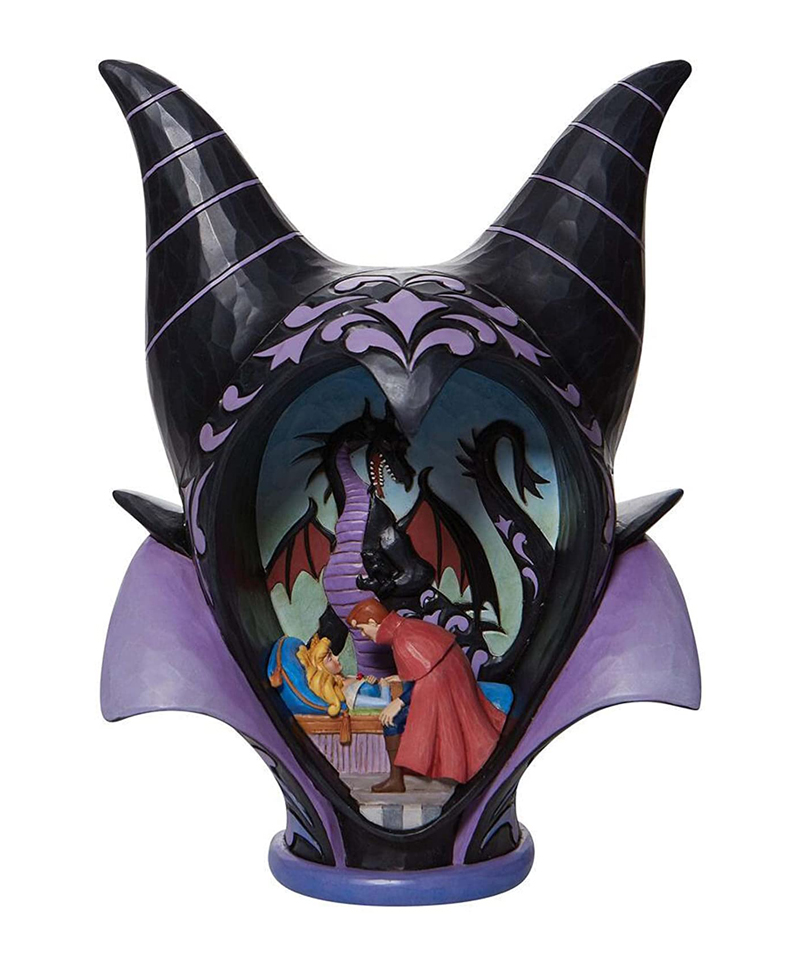Disney Maleficent Headdress “Sleeping Beauty True Love’s Kiss” Statue
This Disney Maleficent Headdress Statue is a Jim Shore Disney Traditions Collection and depicts the scene of “Sleeping Beauty,True Love’s Kiss“. Beautifully hand-painted and crafted from high-quality stone resin with intricate styling and attention to detail. Jim Shore’s unmistakable style evokes a sense of nostalgia with traditional themes, quilt patterns and design motifs inspired by American and European. The Disney Traditions Collection by Jim Shore combines the magic of Disney with the time-honored motifs of handcrafted folk art. Framed within Maleficent‘s horned silhouette, an illustrious Sleeping Beauty scene unfolds. Prince Phillip arrives at Aurora‘s bedside with fairies, Flora, Fauna, and Merryweather, to break the curse before the kingdom falls. Maleficent is the main antagonist of Disney’s 1959 animated feature film Sleeping Beauty. An evil fairy, Maleficent is an incarnation of pure evil, and is responsible for all misfortune in King Stefan’s kingdom. Taking offense at not being invited to the christening of Aurora by King Stefan and his wife, Queen Leah, Maleficent curses the princess to die by pricking her finger on a spinning wheel’s spindle before the sun sets on her 16th birthday. She also appears to be particularly disdainful of Flora, Fauna, and Merryweather, her benevolent rivals. She is frequently accompanied by her pet raven, Diablo. With her dark, elegant design, dramatic and flamboyant animation, and an unlimited arsenal of magic powers at her command, Maleficent is one of the most popular and recognizable Disney Villains, in addition to being one of the primary members of the official franchise.
Sleeping Beauty, or Little Briar Rose, also titled in English as The Sleeping Beauty in the Woods, is a classic fairy tale about a princess who is cursed to sleep for a hundred years by an evil fairy, to be awakened by a handsome prince at the end of them. The good fairy, realizing that the princess would be frightened if alone when she awakens, uses her wand to put every living person and animal in the palace asleep, to awaken when the princess does. The earliest known version of the story is found in the narrative Perceforest, composed between 1330 and 1344. The tale was first published by Giambattista Basile in his collection of tales titled The Pentamerone (published posthumously in 1634). Basile’s version was later adapted and published by Charles Perrault in Histoires ou contes du temps passé in 1697. The version that was later collected and printed by the Brothers Grimm was an orally transmitted version of the literary tale published by Perrault. The Aarne-Thompson classification system for folktales classifies “Sleeping Beauty” as being a 410 tale type, meaning it includes a princess who is forced into an enchanted sleep and is later awakened reversing the magic placed upon her. The story has been adapted many times throughout history and has continued to be retold by modern storytellers throughout various media.
Early contributions to the tale include the medieval courtly romance Perceforest (published in 1528). In this tale, a princess named Zellandine falls in love with a man named Troylus. Her father sends him to perform tasks to prove himself worthy of her, and while he is gone, Zellandine falls into an enchanted sleep. Troylus finds her and rapes her in her sleep, when their child is born, the child draws from her finger the flax that caused her sleep. She realizes from the ring Troylus left her that he was the father, and Troylus later returns to marry her. Another early literary predecessor is the Provençal versified novel Fraire de Joi e sor de Plaser (1320-1340). The second part of the Sleeping Beauty tale, in which the princess and her children are almost put to death but instead are hidden, may have been influenced by Genevieve of Brabant. Even earlier influences come from the story of the sleeping Brynhild in the Volsunga saga and the tribulations of saintly female martyrs in early Christian hagiography conventions. Following these early renditions, the tale was first published by Italian poet Giambattista Basile who lived from 1575 to 1632. Disney Maleficent Headdress “Sleeping Beauty True Love’s Kiss” Statue measures: 10.25 inches / 26 cm x 7 inches / 18 cm x 8 inches / 20 cm.
Disney Maleficent Headdress Statue on Amazon.
Disney Maleficent Headdress Statue on eBay.
Cartoons Statues and Disney Statues.



